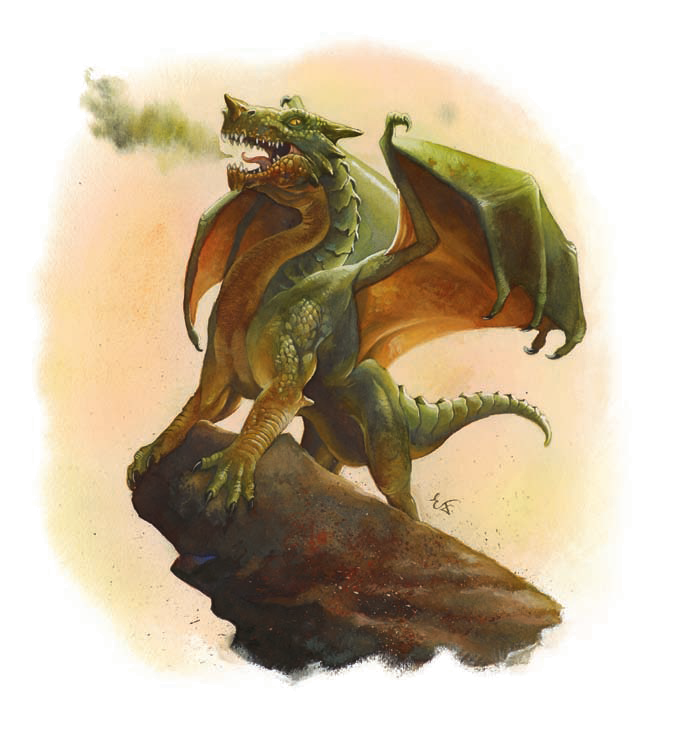Dragon
All mighty apex predators
Dragons (or wyrms) were very powerful and magical creatures. There were several types of dragons, the most common of which were chromatic and metallic which were evil and good respectively. They were an ancient race. Few species that still exist can claim longer lineage. Dragons were the bane of the creator races of Cinera; their line was so old, they had their own realm during the first recorded exploits of the elves. In recent times, the dragons of Cinera were nearly all recluses or at the very least deceptive to their true nature, living amongst other species in polymorphed form.
Abilities
Dragons became stronger as they grew older; they also became larger, more resistant to damages and magic, had a more dangerous breath, and a great deal of other enhanced aspects. Older dragons could cast draconic magic, such as spells with just a few words, and oftentimes they didn't need long and complex ritual involving words, gestures and components like other wizards, and they radiated a mystical fear aura around themselves. After a millennium or two, a dragon reached his maximum development. All dragons had some innate magical abilities, but they varied from race to race. Metallic dragons were often able to shapechange into small animals or human forms, and used this ability to secretly help or watch over humans. Dragons also had some innate powers upon the element they are linked to. For example a red dragon, who breathed fire, had some control over other flames.Basic Information
Anatomy
Dragons are easy to identify, but commonly confused with wyverns.
Dragons have four limbs, a tail, and a pair of wings.
Wyverns only have two limbs, a tail, and a pair of wings. Wyverns (while still intelligent) are not as intelligent as a true dragon.
Genetics and Reproduction
The number of eggs a dragon laid each brood depended on its race, but was usually low, between one and ten. Thanks to their shape-shifting, dragons could also cross-breed with virtually any other creature, creating a half-dragon. The most commonly heard of were in the humanoid races, particularly with human and elves. Any combination was possible, however, even with devils or angels.
Growth Rate & Stages
True dragons are creatures that grow more powerful as they age, despite already having considerable strength upon hatching. Dragons go through several stages throughout their life:
Hatchling. A dragon is considered a hatchling from birth until around 10 years old.
Young. A dragon is considered a young dragon from 10 years old until around 80 years old.
Adult. A dragon is considered an adult from 80 years old until around 750 years old.
Ancient. A dragon that exceeds 750 years of age is considered ancient. There are no further known stages for a dragon after this, and a dragon will live out the rest of its life as an ancient dragon.
Young. A dragon is considered a young dragon from 10 years old until around 80 years old.
Adult. A dragon is considered an adult from 80 years old until around 750 years old.
Ancient. A dragon that exceeds 750 years of age is considered ancient. There are no further known stages for a dragon after this, and a dragon will live out the rest of its life as an ancient dragon.
Ecology and Habitats
Dragons prefer sandy areas and open plains, as long as there is a cave nearby or a mountain to roost in.
Additional Information
Perception and Sensory Capabilities
Dragons were superior in most ways to other creatures - like any predator, they had exceptionally acute senses, which only increased with age.
They had great night vision, and were able to see even when conditions had no light to offer, though not in color. Dragons could also pick up scents very well, utilizing both their sensitive nose and forked tongue, much like a snake. Their hearing was on par with human hearing, although their minds could filter what noise it hears. Dragon taste was also refined, although they did not respond well to sweet flavors, and most dragons didn't discuss why.
Dragons were capable of blindsense, the sense in which eyes, ears, and other senses were used to detect invisible persons or objects.
Civilization and Culture
Naming Traditions
A male dragon is typically named by their patron, whereas a female dragon is named by their mother. There are no conventions to a dragons name.










Comments